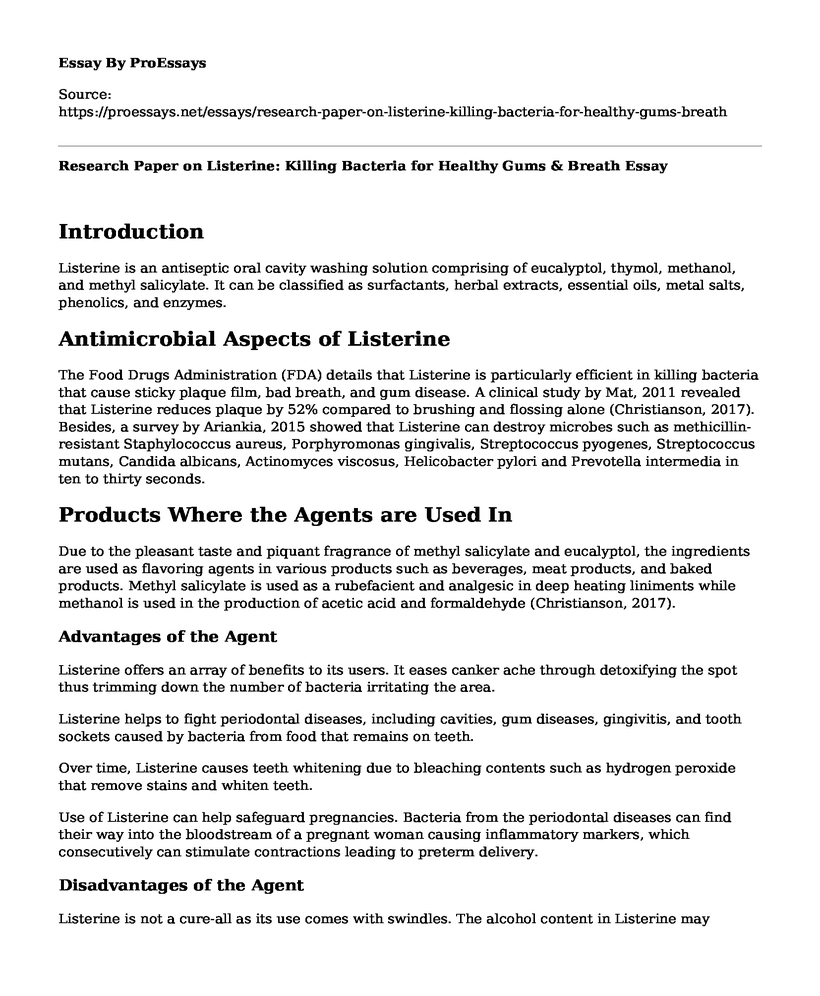Introduction
Listerine is an antiseptic oral cavity washing solution comprising of eucalyptol, thymol, methanol, and methyl salicylate. It can be classified as surfactants, herbal extracts, essential oils, metal salts, phenolics, and enzymes.
Antimicrobial Aspects of Listerine
The Food Drugs Administration (FDA) details that Listerine is particularly efficient in killing bacteria that cause sticky plaque film, bad breath, and gum disease. A clinical study by Mat, 2011 revealed that Listerine reduces plaque by 52% compared to brushing and flossing alone (Christianson, 2017). Besides, a survey by Ariankia, 2015 showed that Listerine can destroy microbes such as methicillin-resistant Staphylococcus aureus, Porphyromonas gingivalis, Streptococcus pyogenes, Streptococcus mutans, Candida albicans, Actinomyces viscosus, Helicobacter pylori and Prevotella intermedia in ten to thirty seconds.
Products Where the Agents are Used In
Due to the pleasant taste and piquant fragrance of methyl salicylate and eucalyptol, the ingredients are used as flavoring agents in various products such as beverages, meat products, and baked products. Methyl salicylate is used as a rubefacient and analgesic in deep heating liniments while methanol is used in the production of acetic acid and formaldehyde (Christianson, 2017).
Advantages of the Agent
Listerine offers an array of benefits to its users. It eases canker ache through detoxifying the spot thus trimming down the number of bacteria irritating the area.
Listerine helps to fight periodontal diseases, including cavities, gum diseases, gingivitis, and tooth sockets caused by bacteria from food that remains on teeth.
Over time, Listerine causes teeth whitening due to bleaching contents such as hydrogen peroxide that remove stains and whiten teeth.
Use of Listerine can help safeguard pregnancies. Bacteria from the periodontal diseases can find their way into the bloodstream of a pregnant woman causing inflammatory markers, which consecutively can stimulate contractions leading to preterm delivery.
Disadvantages of the Agent
Listerine is not a cure-all as its use comes with swindles. The alcohol content in Listerine may irritate canker sores. If the alcohol content is high, it may irritate the canker sore more than soothing it.
Use of Listerine can be used to cover bad breath by patients with pitiable oral cleanliness.
Use of Listerine increases teeth sensitivity as alcohol dissolves the mucus layer leaving teeth vulnerable and more sensitive.
Health Risk to Humans
There has been a concern that the use of Listerine is associated with oral cancer due to alcohol content. However, according to the American Dental Association (ADA), no perfect answers have been given regarding the linkage owing to the nature and design of studies revolving around the subject.
Specific Instructions About the Use
For best results and oral hygiene, Listerine should be used twice a day after brushing the teeth. About 20 milliliters of the solution equivalent to 4 teaspoons should be used without diluting with water each time. The mouth should be rinsed for 30 seconds and then spit it out. The patient should be cautious enough not to swallow the solution.
References
Christianson, D. W. (2017). Structural and chemical biology of terpenoid cyclases. Chemical Reviews, 117(17), 11570-11648.
Cite this page
Research Paper on Listerine: Killing Bacteria for Healthy Gums & Breath. (2023, Feb 17). Retrieved from https://proessays.net/essays/research-paper-on-listerine-killing-bacteria-for-healthy-gums-breath
If you are the original author of this essay and no longer wish to have it published on the ProEssays website, please click below to request its removal:
- Research Paper on Effective Ways to Prevent Cancer
- Nursing Professional Responsibility to Deal With an Aging Population Essay
- How Would the Nurse Actualize Parse's Theory of Human Becoming?
- Recommendation for the Healthcare Career: Nursing
- Transport Proteins on Strike Essay
- Essay on Coronavirus, Covid-19: Contagion Movie Predicted Global Pandemic & Mass Surveillance
- Essay Example on PICOT Format: A Guide to Evidence-Based Practice Research







